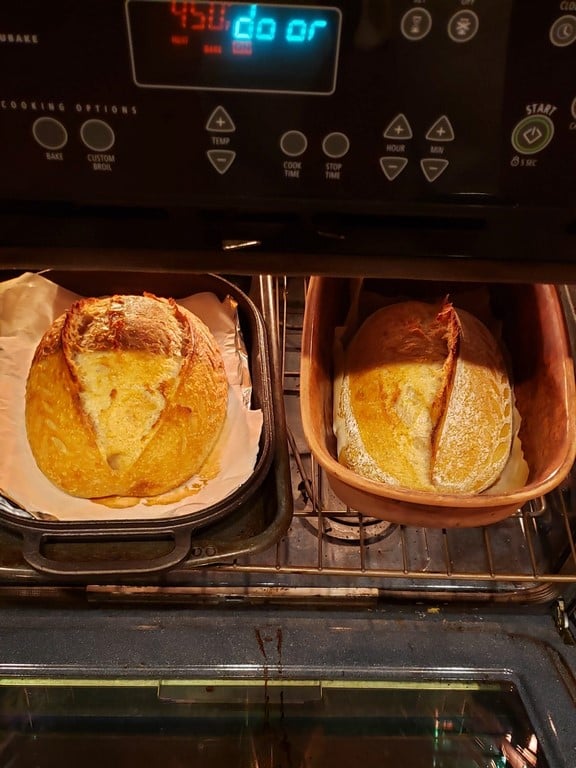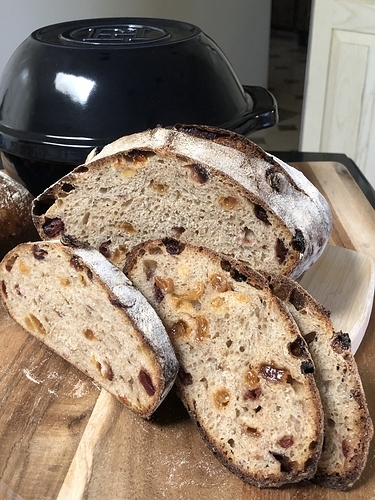I’ve been making do with a variety of kitchen vessels to bake my breads and am ready to buy a dedicated boule baker. I already have an oval clay baker and love the breads it produces. I have a large enameled cast iron Dutch oven, but rarely use it because it’s too big for the small loaves I bake and it weighs a ton so I don’t have a lot of experience with cast iron to compare with clay. I’d love to hear opinions from those of you who have used both. Thanks!
Cast iron on the left, Clay on the right
Same dough, same size score bloom.
Ice cube can go in cast iron, while to add steam to dough in a clay baker, you can paint the dough with water before loading it.
If you drop a clay baker from high up, it will break. If you drop a cast iron baker from high up, it will break something (but it won’t break).
Never had a burnt bread base in clay, whereas cast iron may need a sheet under it and sooner oven temp lowering to prevent over-baking of the base of the bread.
They’re both great…I regularly use both at the same time, and strategize for the heat differences e.g. I always load the clay baker first and put the cast iron baker on the cooler side of my oven.
Thanks, Melissa! Your photos show 2 very similar loaves. Other than the possibility of a darker bottom on the cast iron, do you notice any difference in the rest of the crust or the crumb?
I can see that each has advantages. I was looking at a Lodge Combo-cooker cast iron pot which has a clever design - a deep bottom and a flattish top that can be flipped and used as a frying pan. The top also has a small raised rim so it could be used in reverse with the top as a base and the bottom as a dome like a cloche. And it has the added advantage of being usable for more than baking. But, I love my oval clay baker. Decisions, decisions. I will probably eventually get both.
If I go heavy on ice cubes, I get a thinner, crispier crust. I haven’t noticed a difference in the crumb, clay vs cast iron, but I haven’t analyzed it carefully.
I have the Lodge you’re talking about – two actually, because I used them for side-by-side experiments. Since lockdown, though, one is with a friend who became a sourdough baker a few months ago. It’s a nice pot, and stacks well for storage.
How do you introduce the ice cubes to the cast iron pot? Do you put them in alongside the bread dough after you put it in?
That’s cool that you have the Combo-cooker! How do you use it, with the deep part or the shallow lid as the bottom?
I slip one ice cube under a corner of the foil and parchment that I put under the dough. That way there is no direct contact and I don’t get a weird mushy spot on the crust.
I tried 2 ice cubes a few times, but found that excess steam gelatinized the score opening and seemed to seal it shut too early.
I put the dough in the shallow lid of the combo cooker (that Lodge cast iron doesn’t need the foil layer in my experience).
Great, thanks! I think the combo cooker is going to be at the top of my birthday present list.
I have many covered bakers … I don’t use cast iron because of its weight. I have a spun steel cloche (Breadtopia carries) and various clay bakers. They all work just fine. I almost always put my covered bakers in the cold oven and let them heat up with the oven. It adds to a great crust AND you avoid the loaf sticking to the baker.
Hi, Linda, thanks for the feedback! I have lusted after that spun iron cloche, it’s a thing of beauty! But alas out of my budget. I just recently discovered what happens when you put cold dough in a cold clay baker into a preheated oven - I had to chisel the bread out.
I too am looking into a different baker. I have the Breadtopia Oval Clay Baker. I think I am one of very few whose clay baker’s top wobbles. I discovered this 2 months later so too late for any kind of exchange. Also I am not sure if the wobble developed over use. After noticing the wobble, I also noticed that my crust does not seem as “crisp” as I remembered it could be. I also have an Emile Henry Italian Loaf Baker, and though the top does NOT wobble, when I examine closely the side is not perfectly straight so there is a small gap on one side. So I suppose steam will leak on my Emile Henry baker as well. I think this is the characteristic of clay bakers. That is, there is no way to get a perfect seal with a clay baker. Just wanted to share an argument for why NOT to get a clay baker.
Thanks for your input, Spiderpeck! That’s something that hadn’t occurred to me. Do you use parchment paper with your clay baker? I wonder if using it under the dough with the edges of the paper draped outside the baker between the top and bottom would help to seal it?
I never used parchment paper with my clay baker. Only when I use the dutch oven. Just yesterday, AFTER I’ve already “gifted” my clay baker to my sis-in-law I saw a post in this forum where this person suggested fixing the wobbly top with aluminum foil. So similar concept to what you are thinking of doing with the parchment paper. Here’s a link to his suggestion: Preventing Steam from Leaking on Clay Baker
Yes, aluminum foil seems like an even better idea - it would conform and keep it’s shape better than paper. Oh, no, so sorry to hear that you gave yours away! I found my oval clay baker at a thrift shop in case that’s an option for you and you still want one.
I have an oblong clay baker that I use regularly. I’ve never had trouble with steam escaping (except the one time I accidentally left the lid ajar  ). I usually use a parchment sling to transfer the dough, draping the parchment over the sides which results in a nice, tight feel when putting the lid on. But even without parchment, it works well.
). I usually use a parchment sling to transfer the dough, draping the parchment over the sides which results in a nice, tight feel when putting the lid on. But even without parchment, it works well.
Thanks for your input, Arlo48!
I don’t have photos of both Clay and cast but I’ve compared two cast irons as an FYI: Staub & Le Creuset. Though I prefer Staub for regular cooking, I have had the best results with my old Le Creuset for bread (tho you need to upgrade the lid knob to their metal option). The white interior seems to delay any possible burning over the Staub’s black enamel interior — my Staub bread had a darker bottom in a simultaneous bake.
Also, I get great crackly crusts with cast iron and I never need ice to produce it. The lid creates the closed environment and necessary moisture w/o all that extra effort. My two boule pans are not huge though — seems like I get the best results from a “cocotte” (9” across) that’s only slightly larger than the size of my bannetons (8”). Concentrates the steam and prevents spread with slacker doughs. Plus I can fit two side by side in my smallish oven.
Check out Ken Forkish’ demos on youtube with Emile Henry loaf sized clay bakers. You can fit 2 in at once side by side just like the 9” Le Creuset, and you still get great steam action. The clay bakers are also quite a bit less $$ than Le Creuset cast iron…
Finally, I cannot live w/o the soft white heat proof gloves available here at Breadtopia to allow me to gently and slowly lower the loaves into the pan without messing around w/parchment — completely removes the worry of burning my hands. Essential equipment!
Thanks for all the great input, hransom, especially your comments about the size of your “cocotte”. I usually bake a small loaf, 300g flour, so I’m looking for just such a smaller size baker which was what interested me in the Lodge Combo-cooker. It’s 10" across the top of the pot and 8" at the base which would be just about perfect for me.
I love using Emile Henry Burgundy clay bakers. You can preheat and bake in high temperatures. The covers provide the perfect environment without any need for water-filled pans or baking stones. They have beautiful high-fired glazed exteriors in various colors and shapes.
Thanks for your reply, Carole! The baker is almost as beautiful as you bread!
@hransom I agree those gloves are an ABSOLUTE must-have! I use them every time I bake bread. I swear they have saved my hands and made the job of transferring dough so much easier. Though I do use parchment paper to aid in the transfer of dough, because I find it easier, it works for me and does keep dough from sticking to the bottom of my clay baker. There is no real “wrong” way to transfer dough, IMHO. Every baker has a method that works best for them so that makes their particular method the right one for them.
Leah

